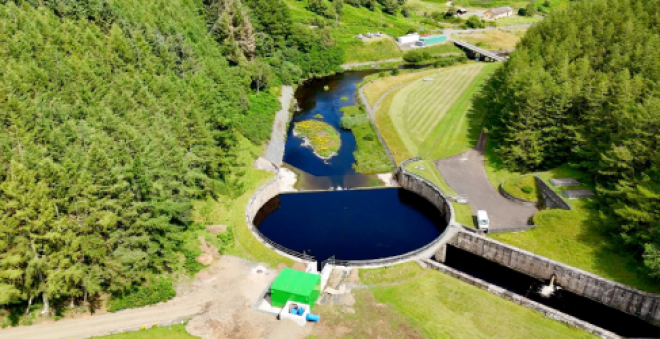Key Milestone for £3m Green Hydro Energy Scheme

Scottish Water has completed construction on a pioneering new type of hydro energy generation scheme at a reservoir in East Lothian, believed to be the first of its kind in Europe.
The £3million scheme, at Whiteadder Reservoir, is expected to offset almost a third of the energy used by one of East Lothian’s largest pumping stations, named Hungry Snout, which takes around 32 millions litres of water per day to Castle Moffat Water Treatment Works before it goes on to supply most of the East Lothian region with drinking water.
Acting Net Zero and Energy Secretary Gillian Martin said:
“This is a very welcome milestone in green energy and Scotland’s goal to reach net zero emissions by 2045. Scottish Water’s £3 million investment in this innovative technology, the first of its kind in Europe, is maximising the value of our water resources, reducing emissions and delivering benefits to customers by reducing costs which can be re-invested.
“Further investment in innovative technology will be required to adapt to the challenges presented by climate change, ensuring our water supply is more resilient and our waterways cleaner.”
The project allows green energy to be generated whilst also accurately controlling the level of the reservoir during seasonal fluctuations in weather.
Through the use of siphon technology, water is drawn up through the intake and over the top of the dam before running down through the siphon, through the hydro turbine, and back to the natural environment. The project has been led by Scottish Water Horizons, the public utility’s commercial subsidiary, and delivered by renewable energy specialists Emtec Energy.
Senior Project Manager at Scottish Water Horizons, Neil Beaumont, said:
“We are delighted to have completed construction of this exciting project which will produce enough green energy to meet 30% of the power needs of the Hungry Snout pumping station and reduce our reliance on drawing energy from the national grid.
“We also wanted to ensure our carbon footprint was as low as possible throughout the construction process, which is why we used divers and barges to sink the pipes under the water – this was a much less intrusive and carbon intensive way of installing the new infrastructure than more traditional methods.”
The investment at Whiteadder will significantly reduce the carbon emissions from the pumping station, saving approximately 111 tonnes of carbon each year, the equivalent of a passenger jet flying from Edinburgh to Sydney, Australia 40 times.
It is expected to generate 0.82GWh of renewable energy per annum from the 199kW turbine.
Pic credit: Scottish Water


